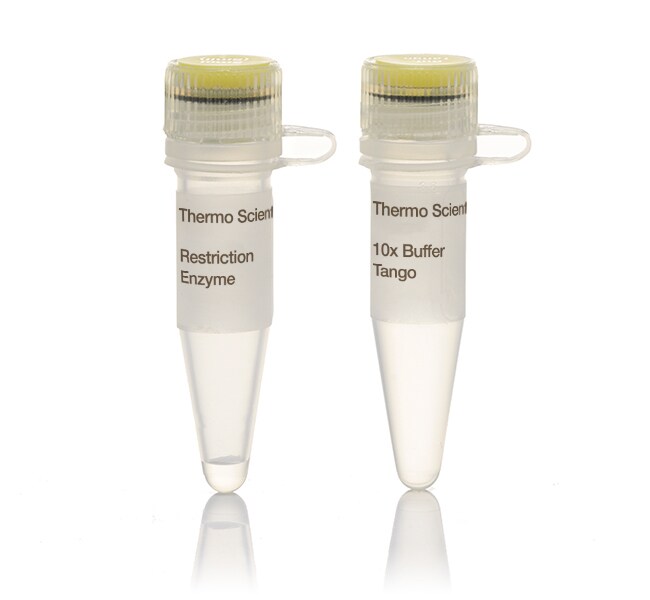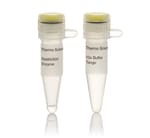Search Thermo Fisher Scientific
SspDI (KasI) (10 U/μL)
| Número de catálogo | Cantidad |
|---|---|
| ER2191 | 250 units |
| 5' | G ↓ | G | C | G | C | C | 3' | ||||
| 3' | C | C | G | C | G ↑ | G | 5' |
La enzima de restricción SspDI (KasI) Thermo Scientific reconoce los sitios G^GCGCC y corta mejor a 37 °C en tampón Tango. Consulte Reaction Conditions for Restriction Enzymes (Condiciones de reacción para enzimas de restricción) para ver una tabla de actividad enzimática, condiciones para digestiones dobles e inactivación por calor para esta y otras enzimas de restricción. Isoesquizómeros: BbeI, DinI, EgeI, KasI, Mly113I, NarI, SfoI.
Las endonucleasas de restricción convencionales Thermo Scientific representan una gran colección de enzimas de restricción de alta calidad, optimizadas para funcionar en uno de los tampones del sistema de cinco tampones. Además, se proporciona el tampón universal Tango para mayor comodidad en digestiones dobles. Todas las enzimas muestran una actividad del 100 % en las condiciones de reacción y tampón recomendadas. Para garantizar uniformidad en el rendimiento, los tampones de enzimas de restricción Thermo Scientific contienen BSA previamente mezclada, lo que mejora la estabilidad de numerosas enzimas y fija sustancias contaminantes que pueden estar presentes en preparaciones de ADN.
Características
• Calidad superior: control de calidad riguroso y proceso de fabricación líder en el sector
• Cómodo sistema de cinco tampones codificados por colores
• Incluye tampón Tango universal para digestiones dobles
• BSA premezclada en tampones de reacción
• Amplia selección de especificidades de endonucleasas de restricción
Aplicaciones
• Clonación molecular
• Mapas de sitios de restricción
• Genotipificación
• Southern blotting
• Polimorfismo en la longitud de fragmentos de restricción (RFLP)
• SNP
Nota: Para conocer la sensibilidad de metilación, consulte las especificaciones del producto.
Figuras

Los clientes que vieron este artículo también vieron
Documentos y descargas
Certificados
Hojas de datos de seguridad
Product Information
Preguntas frecuentes
For optimal results with fast reaction and 100% buffer compatibility, we highly recommend using FastDigest restriction enzymes in double digestion. In certain cases however, it may be possible to perform double digestion using a mix of Thermo Scientific conventional and Fastdigest restriction enzymes. For specific recommendations, please contact our technical service with detailed information about the enzymes and DNA template you plan to use.
We recommend only 2 µl 10X Buffer in digestion of unpurified PCR products in 30 ul since salts and ions from the PCR reaction would be carried over to the digestion reaction.
Find additional tips, troubleshooting help, and resources within our Restriction Enzyme Cloning Support Center.
Star activty may be contributed by:
• Prolonged incubation
• High enzyme concentration
• High glycerol concentration (usually 5% or higher)
• Small reaction volume
Find additional tips, troubleshooting help, and resources within our Restriction Enzyme Cloning Support Center.
Unexpected cleavage patterns may be caused by the following reasons:
• Star activity of the restriction enzyme: Make sure to follow the reaction recommendations as specified in the protocol. Star activity may be improved by changing several key factors such as decreasing the reaction time, increasing the reaction volume, and decreasing the enzyme amount.
• Partial or incomplete cleavage (incomplete restriction reaction): Efficiency of the enzyme can be improved by adding more enzyme, prolonging the reaction time, or purifying DNA samples to remove inhibitory contaminants.
• Contamination with non-specific endonucleases: Non-specific endonucleases may be introduced to the DNA sample and/or the enzyme from improper handling, pipetting, etc.
•Improper reaction setup: Mix the digestion reaction thoroughly.
Find additional tips, troubleshooting help, and resources within ourRestriction Enzyme Cloning Support Center.
The main reason for DNA cleavage reaction failure is the presence of contaminating inhibitors in the template DNA (for example: phenol, chloroform, detergents, ethanol, excess salts, EDTA, etc.). The best way to troubleshoot is to perform control reactions:
1) negative control (experimental DNA in the reaction buffer without the restriction enzyme) to access degradation of DNA by contaminants in the DNA template and/or reaction buffer
2) positive control reaction I (digestion of highly pure control DNA with the restriction enzyme) to access reaction conditions and enzyme activity
3) positive control reaction II (highly pure control DNA + experimental DNA + Restriction Enzyme) to access possible issues with the experimental DNA.
In addition, please check for sensitivity of the restriction enzymes to template DNA methylation.
Find additional tips, troubleshooting help, and resources within our Restriction Enzyme Cloning Support Center.


